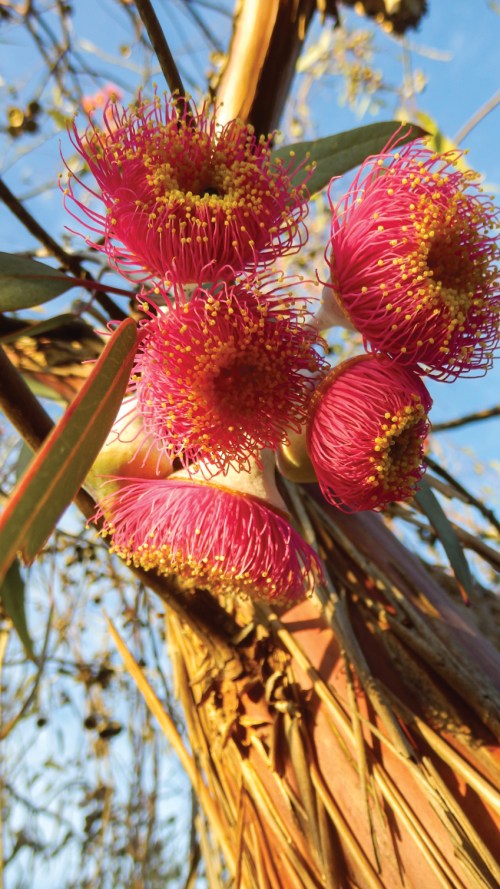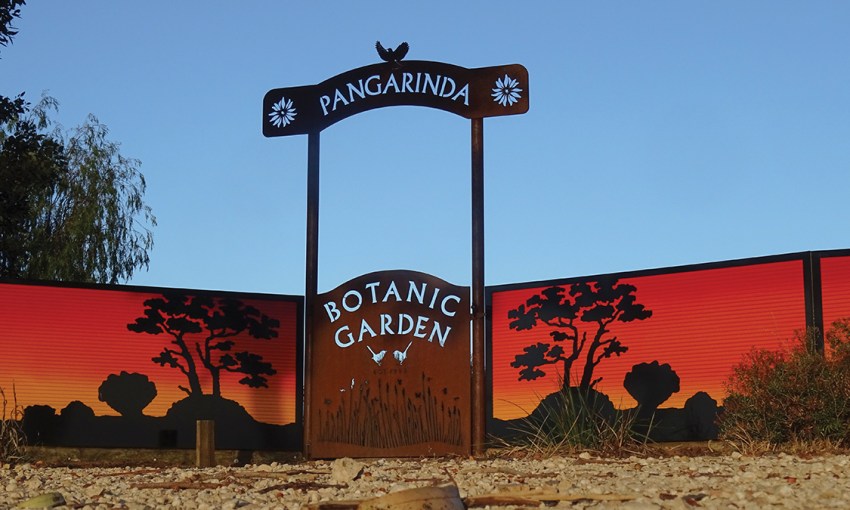Next time you’re heading “off the beaten track”, consider Wellington, where you’ll find something very special that makes visitors and locals alike stop and spend time marvelling at nature.
The natural beauty of people power
Not much more than a 90-minute drive south-east from Adelaide, is Wellington, a small township nestled on the River Murray. Its punt and ferry services provided the necessary main crossing point for goods and people travelling between Adelaide and Melbourne from the late 1830s, until a bridge was constructed at Murray Bridge in 1879. The ferry is still operating, and while Wellington remains a popular transit point, there is something very special in this town to make visitors stop and spend time here.
For, here, you will find the Pangarinda Botanic Garden, a 25-hectare Murrayland gem, which stands as a triumph of people power.
Established in 1993, the aims of the botanic garden were to grow, display and preserve a collection of plants representing the diversity of Australian flora from lower rainfall areas, including rare and endangered species, for scientific, horticultural, educational and recreational use by the community – aims, that some 30 years later, have undoubtably been achieved.
It all started thanks to a Tailem Bend beautification program in the early 1990s, which saw an enthusiastic group of volunteers immersed in a tree-planting project. But once it was finished, they were keen for more.

Discussions ensued with the then-District Council of Meningie (now Coorong District Council), which yielded them a parcel of crown land at Wellington East; the beginning of Pangarinda Botanic Garden.
In Ngarrindjeri language, “Pangarinda” means “sunset” and those lucky enough to be at the gardens near sundown will appreciate its apt naming, as golden rays wash over the land.
The present garden, which features more than 100,000 planted specimens and countless natural sproutings, is a far cry from the original weed-infested paddocks that the small band of dedicated volunteers found.
Their chipping, pulling and spraying, coupled with the installation of kilometres and kilometres of rabbit-proof fencing, has laid the perfect foundation to create this botanic masterpiece. Aided by the council and with support from community groups, businesses, schools and individuals, along with donations and grants over the years, the garden has been able to grow, develop and flourish.

Originally called the Pangarinda Arboretum thanks to its focus on trees, a name change occurred in 2015 to formally recognise the land’s botanic garden status brought about by a broadening of the plant palette to include shrubs, groundcovers and such.
Open during daylight hours, visitors to Pangarinda Botanic Garden soon discover this is not a traditionally curated green space. Best described as an arid land adventure, from the moment you walk through the expertly crafted and stunning entrance, you are immediately immersed and connected with both plants and land.
Respectful of the Ngarrindjeri land, a single shelter is the only structure on site. It is an information bay, a perfect place to meet, gather knowledge and start your journey. Bring a hat, walking shoes, water and food, because there is no catering on-site. Meandering paths circumnavigate and weave through the extensive grounds. The site’s undulating terrain provides excellent vantage points along the walks to appreciate the vista, and wheelchair accessible paths have been installed.
Sandy soil, which dominates the area, and low rainfall, have been the key determinants in plant selection. Local Mallee species have been paired with other plants of the River Murray environs, while dedicated spaces have been made for other plants from the Flinders Ranges, central Australia, and Western Australia.

Inaugural chairperson of the Pangarinda Botanic Garden, John Barrie, and his wife, Julie, are still involved and have the same enthusiasm for this project three decades on. Both they, and other volunteers, such as fellow inaugural member, Kate Bartlett, are passionate about showcasing the gamut of common, endangered and rare native plant species.
This is a garden of surprise and delight for both visitor and volunteer alike. John notes that once this previous farming property had ceased sheep grazing and the volunteers began removing weeds and stabilised the constant smothering sand drifts, something magical began to happen: without any assistance, banksia, carpobrotus and other local species began to sprout naturally. This regeneration showed the land was beginning to heal.
The past 30 years have seen a steady program of planting by the volunteers with assistance along the way from school groups, plant enthusiasts and organisations. A massive undertaking and, of which, each visitor is the beneficiary.
Local and commercially available plant species are represented plus plants threatened by habitat loss and land management practices. In keeping with the Pangarinda Botanic Garden’s charter, preservation of these rare and endangered species is vitally important. Some of these plants have qualities still untapped, be it their ornamental, food, medicinal, or other x-factor. This garden focuses on giving sanctuary to those vulnerable native plants fast disappearing in the wild.

Pangarinda is a botanic garden for all seasons. Compact clusters of grey cottonhead (Conostylis candicans) with vibrant yellow blooms and striking grey foliage can be enjoyed from now until summer. Lechenaultia’s electric blue flowers are a beacon through winter and spring, as are the many wattles and grevilleas. Drifts of low-growing muntries, filled with spicy, apple-flavoured berries, are at their productive best from late summer.
Trees, shrub and groundcover banksias are a dominant species throughout the garden. Banksia blechnifolia, a spreading prostrate shrub with springtime reddish-pink candlestick inflorescence, is a visitor favourite. Wander through the impressive kangaroo paw groves, then challenge yourself to find as many of the more than 250 different types of eremophila as possible. Or cast an eye downwards to discover the many native orchids planted and naturalising throughout.
While plants take pride of place, there are plenty of active insects, birds and animals that call Pangarinda Botanic Garden home. Butterflies flit and pollinators busy themselves from plant to plant which, in turn, attracts a wide number of insect and nectar-feeding birds. Their twitters, chirps and squarks are the soundtrack of your walk.

Keep an eye out for echidnas constantly on ant-trail hunts, you will see where they’ve been active on the walking paths. Dainty and incredibly cute pygmy possums scurry up branches to feed on nectar-filled flowers. Take your time and keep your eyes and ears tuned to nature. You can well understand why photographic clubs and art groups spend hours and hours immersed here.
Pangarinda Botanic Garden is a true gem and one you must make time to visit next time you’re looking to go “off the beaten track”.
This article first appeared in the June 2023 issue of SALIFE magazine.



